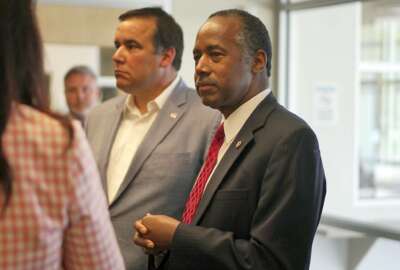 Exclusive
Exclusive One reorganization idea that nearly everyone can agree on
Communication and transparency during the government reorganization process is going well for some, and not for others.
Ask any stakeholder about the Trump administration’s efforts to reorganize government and restructure the federal workforce, and they’ll give you a different answer about how it’s going.
Some agencies touted the thousands of comments they received from their employees and the town halls they held across the country to solicit ideas. Employees at one agency say they haven’t had a say in the department’s upcoming changes.
Another agency’s senior executives have said they haven’t been involved in the reorganization planning process at all.
The National Treasury Employees Union said there’s been little communication and engagement between the administration and front line employees as agencies gather ideas and develop reform plans.
“I don’t believe that at the present time, that’s occurring effectively,” NTEU National President Tony Reardon said Wednesday during a Senate Homeland Security and Governmental Affairs Regulatory Affairs and Federal Management Subcommittee hearing. “Without question, agency management and frontline employees must engage, work together and figure some of those things … where paperwork is unnecessary, where [things] are duplicative, where they’re doing work … that they shouldn’t be doing. I totally agree. That all has to be worked out. Those changes must be made.”
Wednesday’s session was the second of the Senate subcommittee’s hearings on the Trump administration’s government reorganization executive order.
For Sens. James Lankford (R-Okla.) and Heidi Heitkamp (D-N.D.), the chairman and ranking member of the subcommittee, recent conversations with federal employees are informing their concept of the government reorganization.
“I had a federal employee who came and caught me, introduced themselves and said, ‘We have a lot of work to be able to do. There’s a lot of things we’re doing we shouldn’t do. There’s a lot of things we’re doing that are wasteful. I know I’m filling out papers that no one is reading. I want to do purposeful work,'” Lankford said.
He recalled another conversation with a federal manager, who in explaining to Lankford why a particular Transportation Department program existed simply said, “I have people that do that every day.”
Those conversations are informing Lankford’s view of his own role in overseeing the administration’s reorganization effort.
“I want to make sure their opinions are being heard, because they have ideas,” Lankford said of agency employees. “They know the loss that’s happening and where they’re spinning their wheels and not accomplishing things. How can we pull those opinions out and get them to a larger voice?”
NTEU said it solicited ideas from each of its local chapters. It sent letters to individual agencies with those ideas. Reardon said NTEU received few responses from those agencies and other than a meeting with senior adviser Linda Springer before she retired, little to no input from the Office of Management and Budget.
The subcommittee invited OMB to testify at Wednesday’s hearing but the agency declined. Lankford said after the hearing that it was too early in the reorganization process for OMB to testify and said the agency would speak publicly on the Hill at a later time.
Agencies have until Sept. 30 to submit their final reform plans, along with a method for measuring employee performance, to OMB.
Too many layers of management
Yet in some cases, multiple stakeholders in the administration’s reorganization efforts share similar ideas.
Both NTEU and several thinktanks say they see too many layers of management within federal agencies.
The number of management layers at a typical agency has more than doubled since the 1960’s, according to a 2014 Brookings Institution study.
Consolidating management functions was a common suggestion from NTEU members.
Customs and Border Protection, for example, has one supervisor for every 5.7 employees, Reardon said. In 2003, CBP had one supervisor for every 12 employees, he said.
That’s far too many managers for the agency and too few CBP officers Reardon said. He said the agency needs at least 4,000 CBP officers and 631 agriculture specialists. CBP was at least 1,600 border patrol agents below the congressional staffing floor of 21,370.
In his written testimony, he described seven other agencies with similar problems.
Increasing telework, hiring more support staff and filling existing vacancies were other common suggestions from NTEU members.
But there’s less agreement on other ideas — like reforming the federal employee compensation and personnel system.
“If we don’t tackle fundamental personnel reform in conjunction with reorganizations you won’t get the benefits that you hope,” Robert Shea, a former OMB associate director for administration and government performance and now principal at Grant Thornton, said. “Agencies cannot recruit and retain the workforce that they need to accomplish their missions. It’s the chief challenge we find when we survey chief human capital officers, chief financial officers [and] chief information officers. Unless agencies have the flexibility to mold the workforces they need to accomplish the mission you hope they’ll accomplish when you reorganize them, you won’t get there.”
For the Heritage Foundation and Cato Institute, which both testified at the subcommittee hearing, reforming the personnel system would make their reorganization recommendation lists.
Heitkamp recognized that some reorganization suggestions will spark more politically charged argument than others. It may take legislative changes to implement some ideas, but she suggested Congress and the administration focus on “low hanging fruit” first.
“There comes a time when you have to say, ‘Look, we lost that fight. Let’s focus on the things we can agree on. Let’s focus on duplicative programs. Let’s focus on not the ideological problems,'” Heitkamp said. “Maybe those come later.”
Both Shea and Rachel Greszler, a Heritage research fellow, suggested the administration create a commission that develops a list of specific recommendations that may require legislative changes. Congress should vote on the package of suggestions altogether, not each individually.
Any other way would be too difficult, Shea said, as the surrounding government “ecosystem” of federal contractors, congressional committees and other organizations make implementing true, meaningful reform immensely difficult.
“Those tentacles make it really difficult to reform those organizations,” he said. “Everybody, I think, has good intent. They want the mission to succeed, but they’ve become too aligned to the status quo to want to move to something different. There’s an enormous fear about what will result afterwards. Who will lose? Someone will have to lose. I don’t think that necessarily has to be the case.”
Copyright © 2025 Federal News Network. All rights reserved. This website is not intended for users located within the European Economic Area.
Nicole Ogrysko is a reporter for Federal News Network focusing on the federal workforce and federal pay and benefits.
Follow @nogryskoWFED






